
Vol. I, No. 5, July 2023
The growing popularity of agritourism weddings
Weddings reflect society and our values. As culture shifts, so do weddings. The choice of ceremony locations is becoming more important as couples want to plan a personalized wedding that reflects their personalities, values, and relationship together. The shift is proving to be good news for agritourism wedding venues.
For the first time, farms, barns, and ranches are tied with banquet halls as the most popular wedding venues. In 2022, there were 2.4 million weddings in the U.S. Twenty percent of them, nearly one-half million, took place on a farm or ranch (480,000).
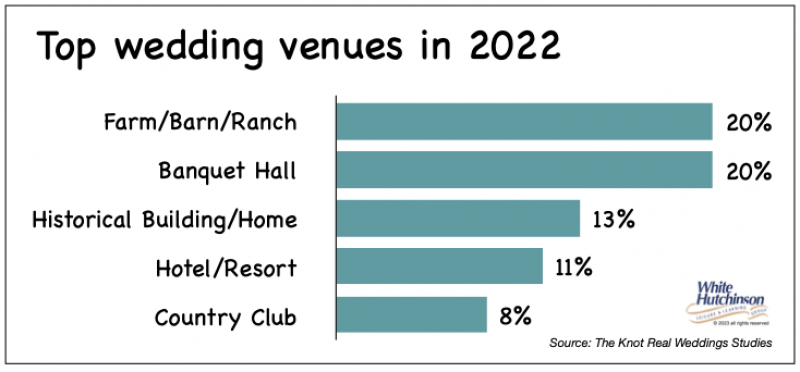
In 2009, only 2% of weddings took place at an agritourism venue: popularity has grown tenfold.
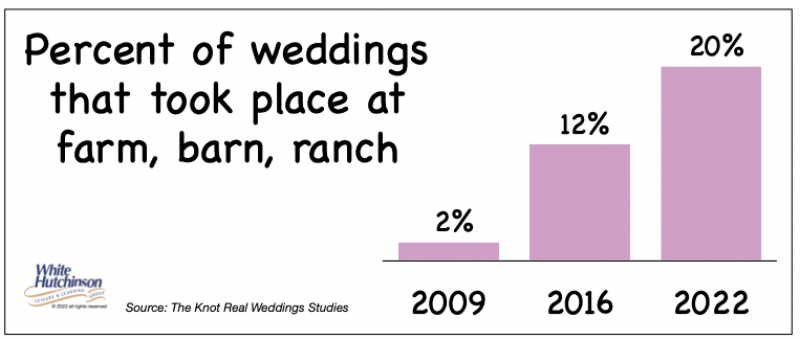
Many factors have contributed to the growing appeal of agritourism venue weddings:
- Rustic Charm and Natural Beauty: Barns offer a low-key, rustic aesthetic that goes along with them. Farms and ranches offer a picturesque and pastoral setting that exudes natural beauty. The serene landscapes, rolling hills, charming barns, and open fields create a romantic and idyllic atmosphere that many couples find irresistible.
- Escape to Tranquility: Unlike traditional indoor weddings, these weddings provide a peaceful and tranquil escape from the hustle and bustle of urban life. The serene countryside setting allows couples and their guests to unwind, relax, and immerse themselves in nature's embrace.
- Intimate and Cozy Atmosphere: Farm, barn, and ranch weddings create an intimate and cozy atmosphere. The rustic ambiance, warm lighting, and natural surroundings foster a sense of closeness among guests, encouraging a more relaxed and enjoyable celebration.
- Connection to Nature and Sustainability: Many couples are drawn to agritourism weddings due to their connection to nature and sustainability. These venues often prioritize eco-friendly practices, such as locally sourced farm-to-table cuisine, reducing waste, and incorporating sustainable decor elements.
- Unique Photo Opportunities: The natural beauty of farm, barn, and ranch venues provides an abundance of unique photo opportunities. Couples can capture stunning images amidst blooming fields, rustic barn doors, old wooden structures, and enchanting sunsets, creating cherished memories to last a lifetime.
-
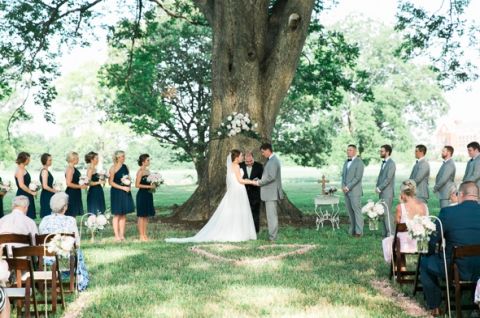 Outdoor Ceremonies and Receptions: Many couples appreciate having
their ceremony and reception outdoors, surrounded by nature. Outdoor
ceremonies provide a romantic backdrop, and outdoor receptions allow guests
to enjoy the fresh air and embrace the beauty of the natural surroundings.
72% of weddings took place fully or partially outdoors in 2022.
Outdoor Ceremonies and Receptions: Many couples appreciate having
their ceremony and reception outdoors, surrounded by nature. Outdoor
ceremonies provide a romantic backdrop, and outdoor receptions allow guests
to enjoy the fresh air and embrace the beauty of the natural surroundings.
72% of weddings took place fully or partially outdoors in 2022.

- Nostalgia and Vintage Appeal: Farm and barn weddings evoke a sense of nostalgia and vintage charm. They harken back to simpler times, reminiscent of romanticized rural life, and appeal to couples seeking a unique and timeless wedding experience.
The combination of rustic charm, natural beauty, personalized options, and a connection to nature has contributed to the growing popularity of farm and barn weddings. These venues offer a romantic and enchanting escape that resonates with couples seeking a distinctive and unforgettable wedding celebration.
External factors contributing to their increased popularity include:
- Wedding Industry Recognition: Farm and ranch weddings have gained recognition and coverage in the wedding industry. Numerous wedding magazines, blogs, and websites feature articles, real weddings, and vendor listings specifically dedicated to farm, barn, and ranch weddings.
- Social Media Influence: Platforms like Pinterest, Instagram, and Facebook are replete with farm and barn wedding inspiration, showcasing various aspects such as decor, dresses, photography, and more.
- Wedding Planner Recommendations: Wedding planners and coordinators often suggest farm and barn venues to couples seeking a rustic, charming, or unique wedding experience.
- Testimonials and Reviews: Positive testimonials and reviews from couples who've had farm and barn weddings contribute to their growing popularity. Word-of-mouth recommendations and experiences shared through online platforms further enhance the appeal of these wedding styles.
The average 2022 wedding + reception cost $29,195, with one-sixth costing more than $30,000 (16.4%). The average number of guests was 127, with one-third of weddings having 150 or more guests (32%).
The most popular months for weddings, when most weddings occur (52%), are in May and June in the Spring and September and October in the Fall, perfect times when both the indoors and outdoors can be enjoyed at farms and ranches.
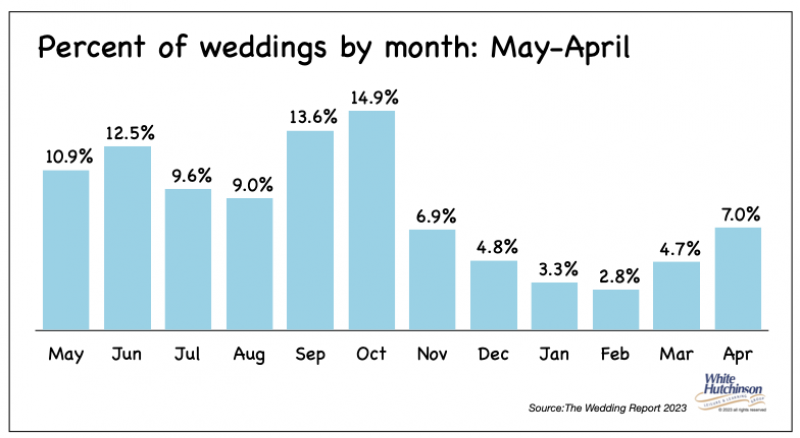
In 2022, the 25-39 age group accounted for the majority of weddings (54%), and 56% of all wedding spending.
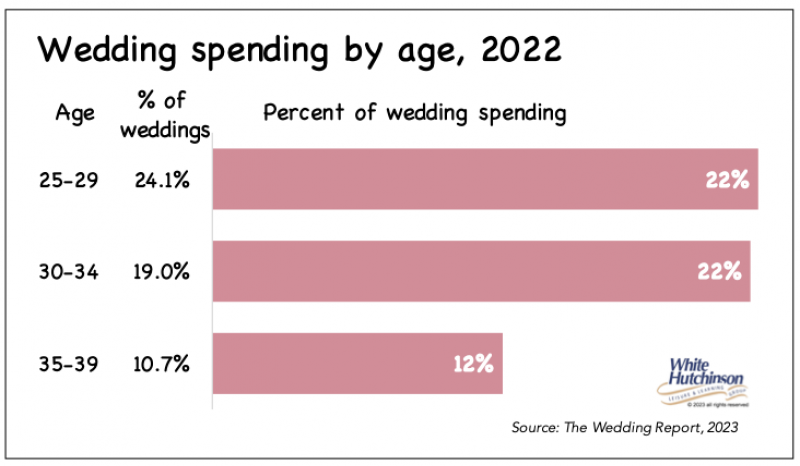
Weddings have become very gentrified. People with a bachelor's or high degree now account for 38% of all marriages, an increase from 29% in 2008.

In 2022, couples with at least one person with a bachelor's or higher degree accounted for 51% of all wedding spending.
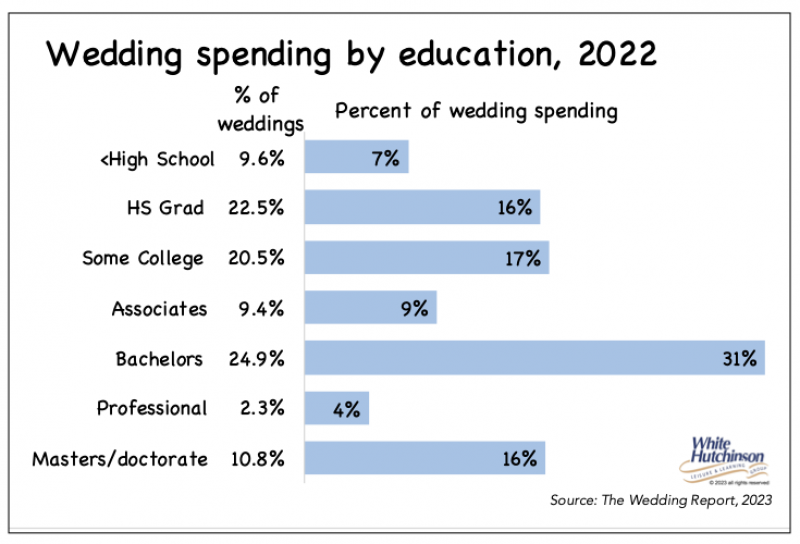
Modern weddings have gone from celebrating the "Big Day" to the "Big Year" with what is being called "the wedding sprawl." Engaged couples are now indulging in multiple celebrations. It has become more common to have an engagement bash, a bridal shower, a bachelor and/or bachelorette weekend, and even a will-you-be-my-bridesmaid party. Then when it comes time for the actual reception and wedding, there are additional events, including welcome drinks, a rehearsal dinner, and a morning-after brunch. We're even seeing a short mini-moon right after the festivities followed by the honeymoon. Sometimes there's even an early-moon before all the celebrating begins. All these festivities allow agritourism to capture some of the wedding revenues even if they don't host the wedding.
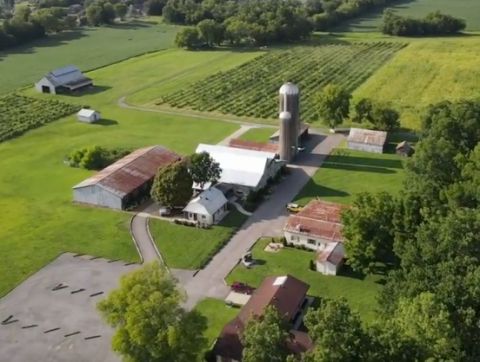
Our company's latest farm wedding and private event project was just completed at the 240-acre Williamson Family Farm just outside Nashville in Murfreesboro, TN. For the last seven years, part of the farm has operated as The Grove, a wedding and corporate event venue. The farm's owners took over management of the farm from its previous lessor three years ago. We've worked with the owners ever since as designers and producers on a multi-million-dollar investment of significant upgrades, renovations, and expansion. To maintain the authentic and rustic look of the buildings, we utilized weathered wood and exterior metal from demolished buildings so the renovations, new buildings, and additions would continue to capture the original rustic authentic look. Our design and construction management work included:
- Renovation of the farmhouse into an office
- Renovation of the former farmhouse garage into a groom's suite
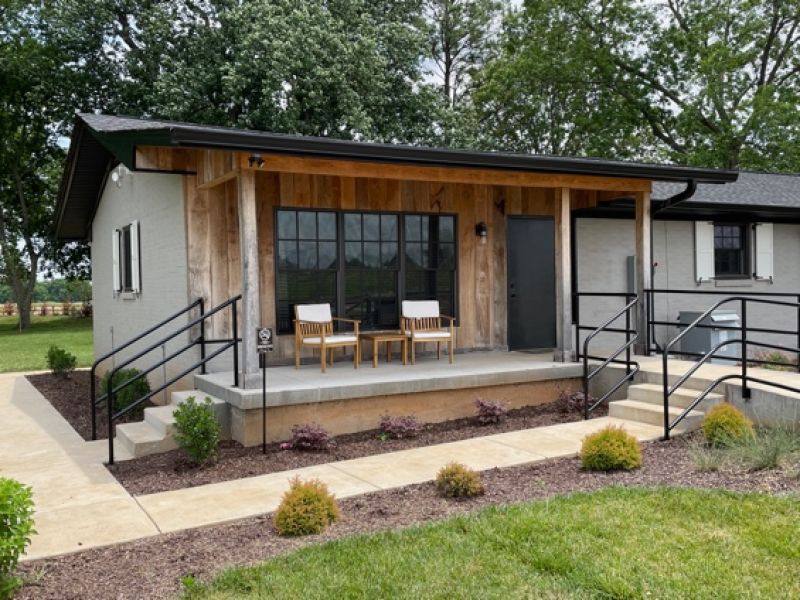
- Development of a free-standing bridal suite
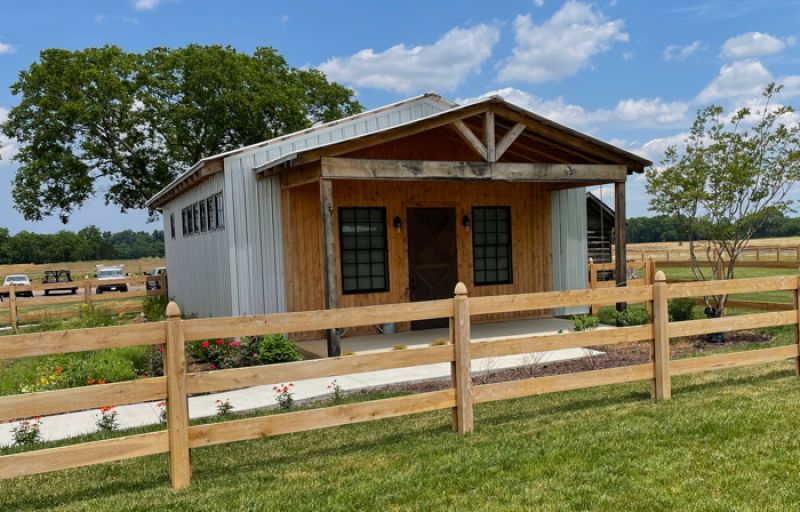
- Major renovations to the main barn to meet fire code and the addition of a catering area and buffet serving area
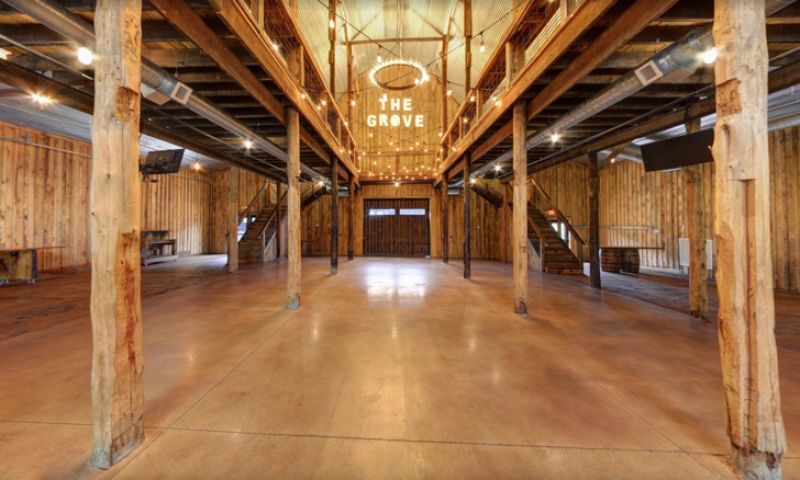
- Renovations to the loafing barn as another event venue, including a catering area and a buffet area
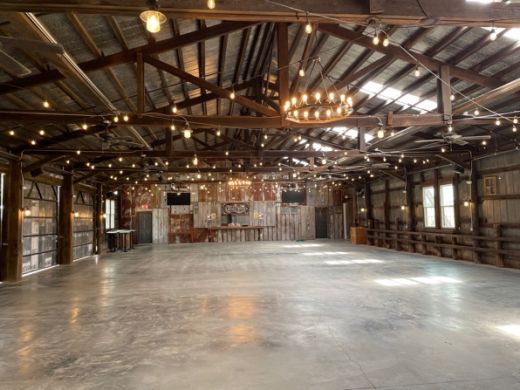
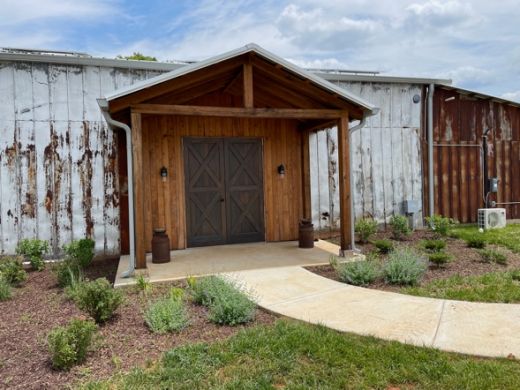
- An addition to the loafing barn that included four public restrooms, a 2nd bridal suite, and a 2nd groom's suite.
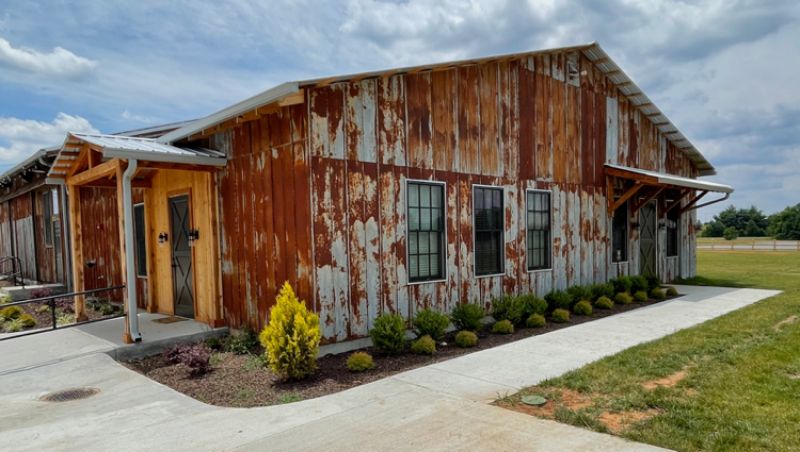
Loafing barn addition


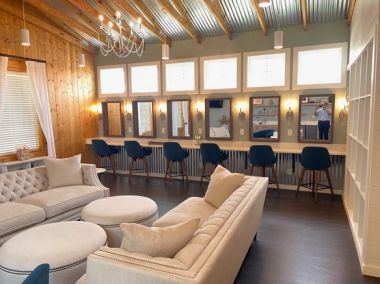
Bridal Suites
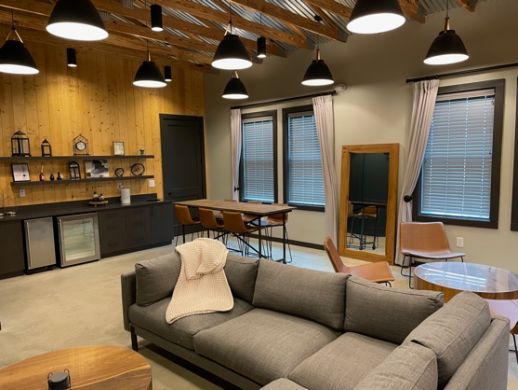
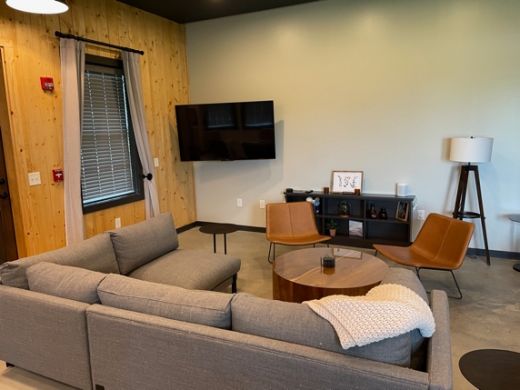
Groom's Suites
- Major site improvements include a paved parking lot for 200 vehicles, an additional stone parking area for 400 more vehicles, concrete walks and drives, and an entry pavilion
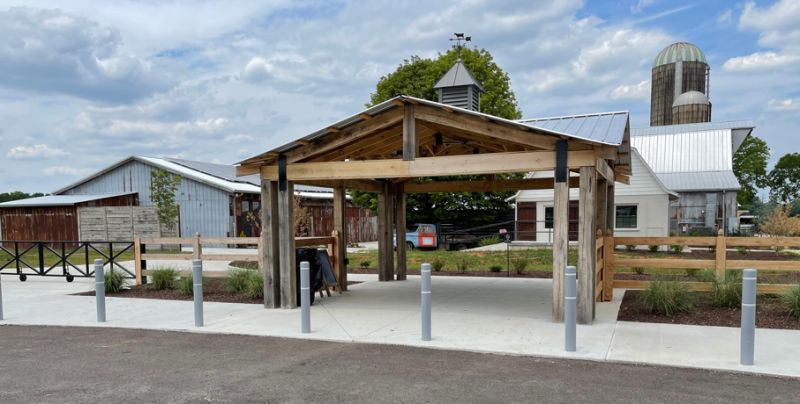
- Total renovation of the kitchen that was in the former shop area for the production of homemade ice cream and baked goods and to accommodate u-pick-to-kitchen cooking experiences and intimate farm-to-table dinners
- A new residential building with two units, one that can be a honeymoon suite
- Construction of a maintenance barn
- Solar electric that supplies the majority of the farm's electricity
- Major landscaping improvements
The private event campus can now host two simultaneous weddings or group events for up to 300 people each in its two barns. Including the outdoor grounds, the farm can host a major private event for up to 1,500 people.
We continue working on the farm's renovation to include an interactive animal area, public festival grounds, an amphitheater, and conversion of the farm to regenerative organic crop production to supply crops for all the farm's events and development of apple orchards to supply a cidery to open in three years.
Subscribe to Agritourism Today



